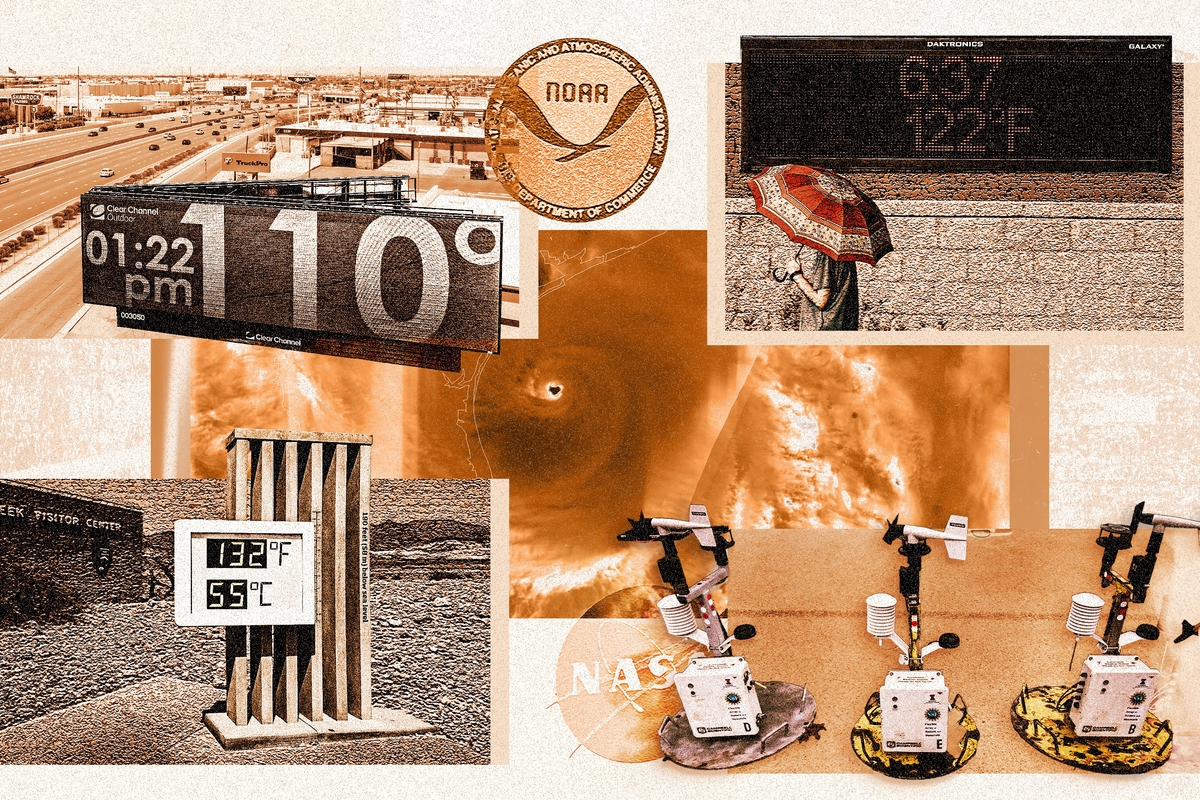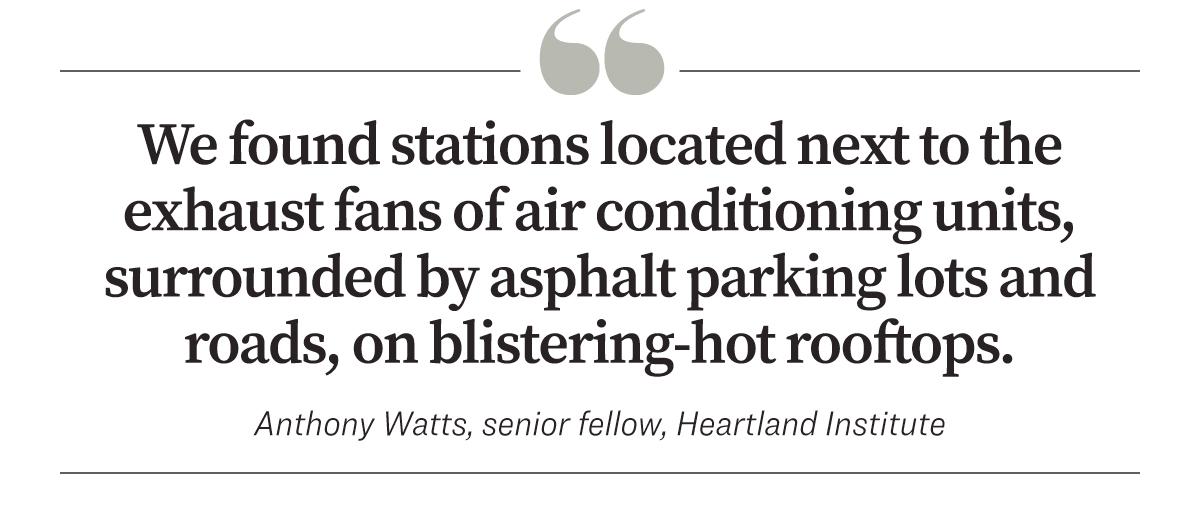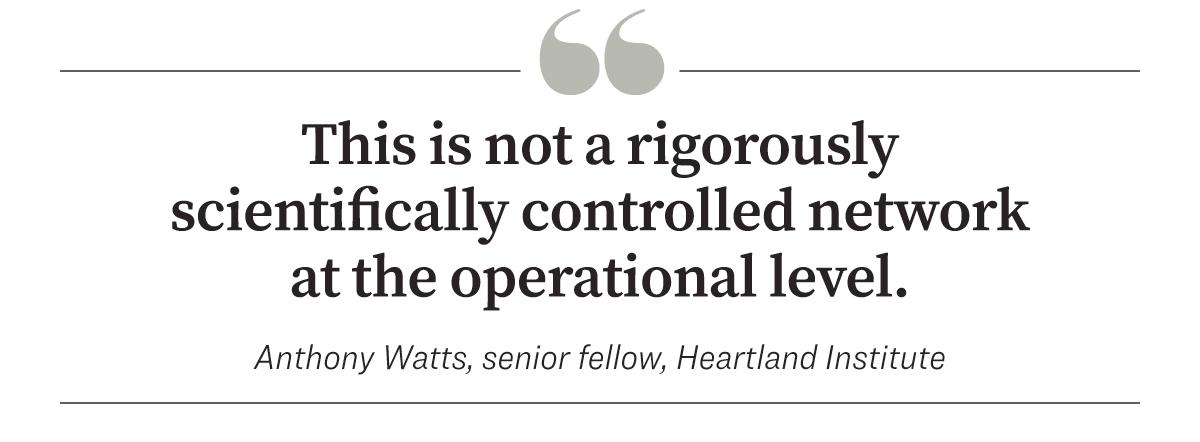Trillions Spent on ‘Climate Change’ Based on Faulty Temperature Data
Meteorologist finds 96 percent of NOAA temperature stations located in
‘urban heat islands,’ including next to exhaust fans
and on ‘blistering-hot rooftops.’
TheEpochTimes.com
After the agreement, global spending on climate-related projects increased exponentially.
That’s more than double the spending rate in 2019 and 2020, which came in at $653 billion per year, and it’s significantly up from the $364 billion per year in 2011 and 2012, the report found.
Despite the money pouring in, the National Oceanic and Atmospheric Administration (NOAA) reported that 2023 was the hottest year on record.
“A warming planet means we need to be prepared for the impacts of climate change that are happening here and now, like extreme weather events that become both more frequent and severe.”
But a growing chorus of climate scientists are saying the temperature readings are faulty and that the trillions of dollars pouring in are based on a problem that doesn’t exist.
“And with that large of a number, over 90 percent, the methods that NOAA employs to try to reduce this don’t work because the bias is so overwhelming,” Mr. Watts told The Epoch Times.
“The few stations that are left that are not biased because they are, for example, outside of town in a field and are an agricultural research station that’s been around for 100 years ... their data gets completely swamped by the much larger set of biased data. There’s no way you can adjust that out.”
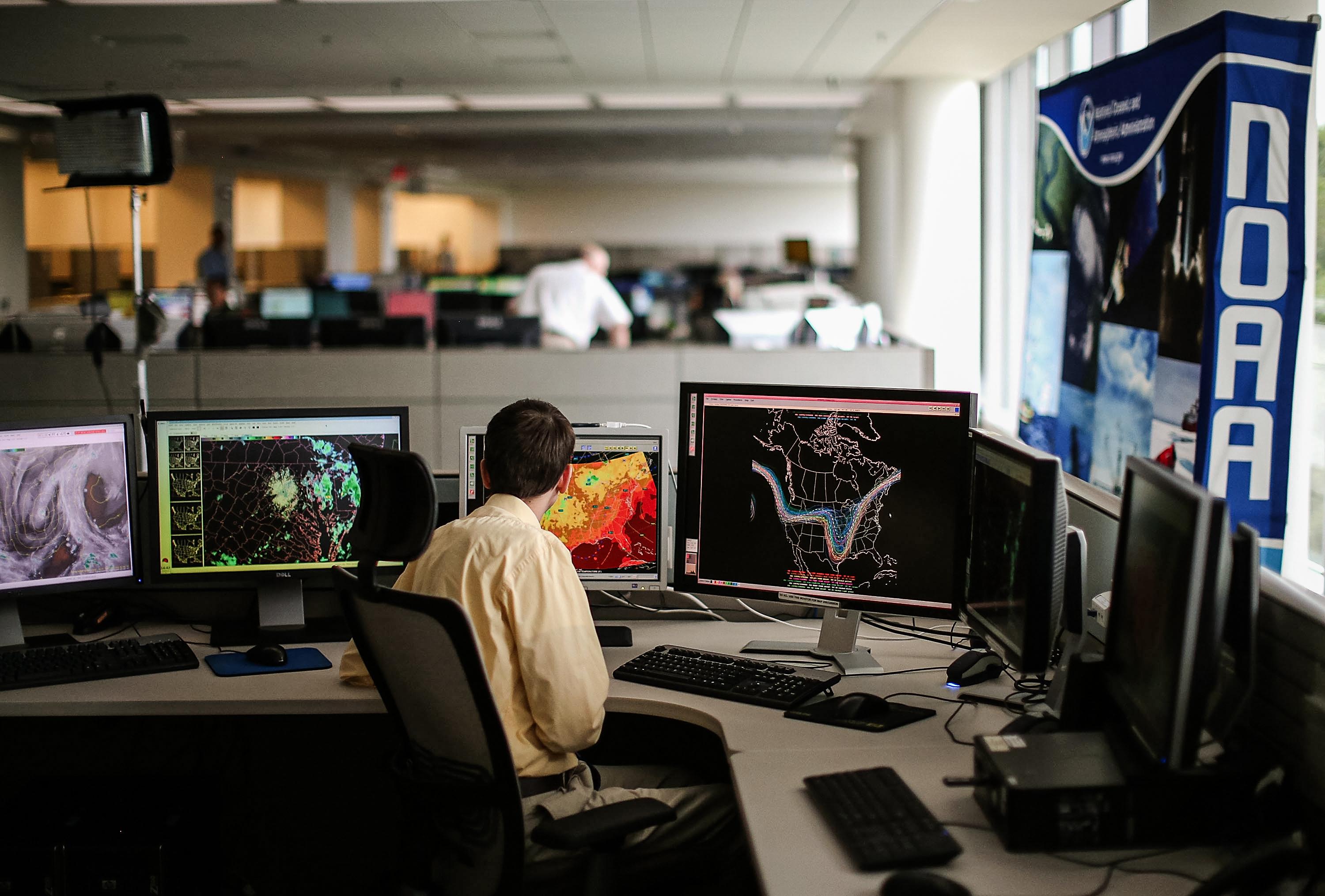
A meteorologist monitors weather in NOAA's center for weather and climate prediction
in Riverdale, Md., on July 2, 2013. (Mark Wilson/Getty Images)
Meteorologist Roy Spencer agreed.
“The surface thermometer data still have spurious warming effects due to the urban heat island, which increases over time,” Mr. Spencer said.
He is the principal research scientist at the University of Alabama, the U.S. Science Team leader for the Advanced Microwave Scanning Radiometer on NASA’s Aqua satellite, and the recipient of NASA’s Exceptional Scientific Achievement Medal for his work with satellite-based temperature monitoring.
Mr. Spencer also said computerized climate models used to drive changes in energy policy are even more faulty.
Lt. Col. John Shewchuk, a certified consulting meteorologist, said the problems with temperature readings go beyond heat bias. The retired lieutenant colonel was an advanced weather officer in the Air Force.
“I was able to confirm what others have found. It is obvious that, overall, the past temperatures were cooled while the present temperatures were warmed.”
Faulty Temperature Readings
The urban heat island effect causes higher temperatures in areas where there are more buildings, roads, and other forms of infrastructure that absorb and then radiate the sun’s heat, according to the Environmental Protection Agency.
Consequently, NOAA requires all its climate observation stations to be located at least 100 feet away from elements such as concrete, asphalt, and buildings.
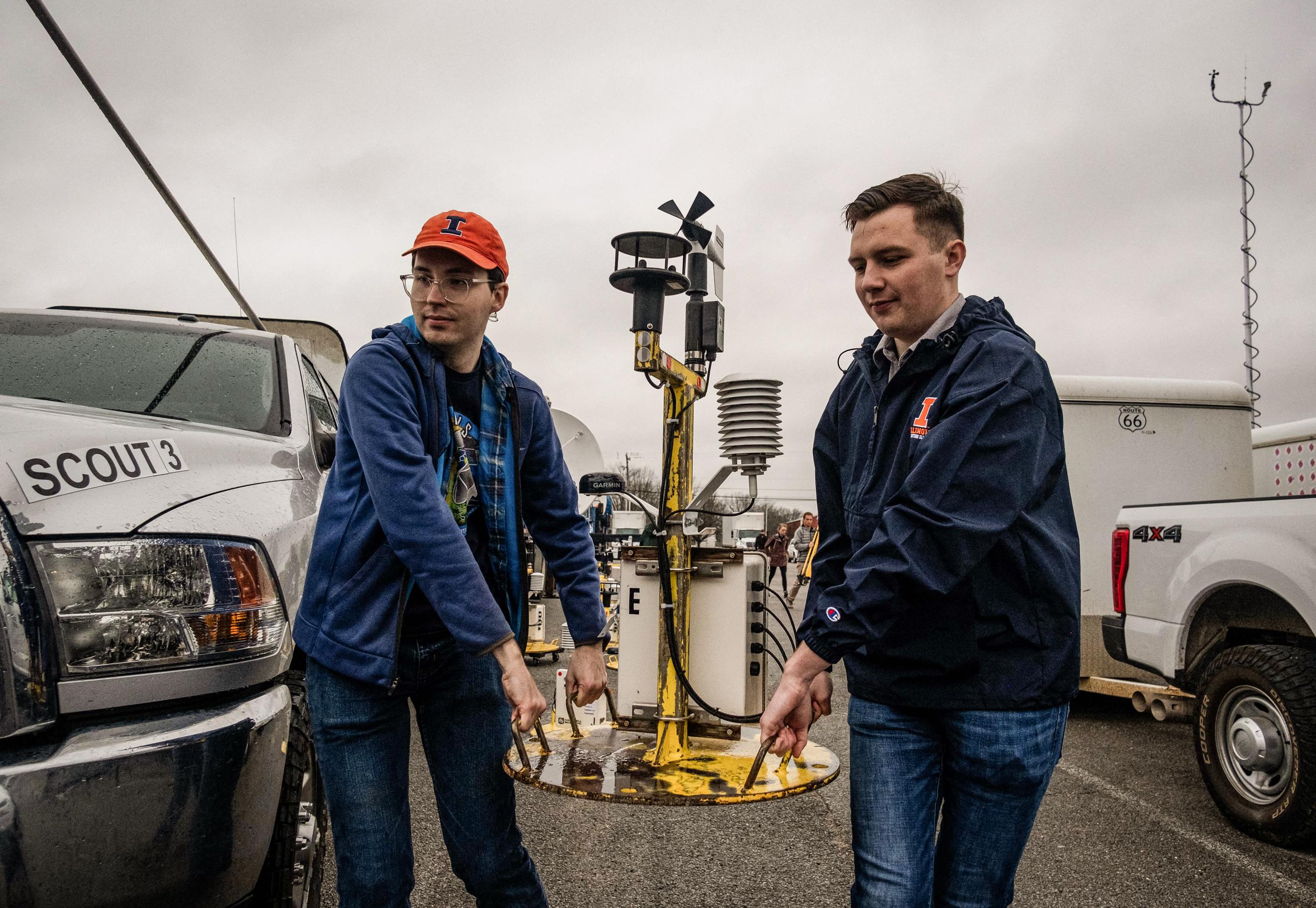
Students of the University of Illinois carry a weather station during a NOAA education day on tornadoes,
in Memphis on Feb. 8, 2023. (Seth Herald/AFP via Getty Images)
“We found stations located next to the exhaust fans of air conditioning units, surrounded by asphalt parking lots and roads, on blistering-hot rooftops, and near sidewalks and buildings that absorb and radiate heat,” Mr. Watts said.
“We found 68 stations located at wastewater treatment plants, where the process of waste digestion causes temperatures to be higher than in surrounding areas.”
The report concluded that the U.S. temperature record was unreliable, and because it was considered “the best in the world,” global temperature databases were also “compromised and unreliable.”
CN data due to biases introduced by such means as undocumented site relocation, poor siting, or instrument changes,” the OIG report reads.
“All of the experts thought that an improved, modernized climate reporting system is necessary to eliminate the need for data adjustments.”
Despite the assurances, Mr. Watts had doubts about NOAA addressing the issues and in April 2022 and May 2022, he and his team revisited many of the same temperature stations they had observed in 2009.
“There are two main biases in the surface temperature network for the United States, and most likely the world, that I have identified,” Mr. Watts said.
“The biggest bias is the urban heat island effect. What happens is that because heat is retained by the surfaces and released into the air at night, the night’s low temperature is not as low as it could be if the thermometer were outside of town and in a field.”
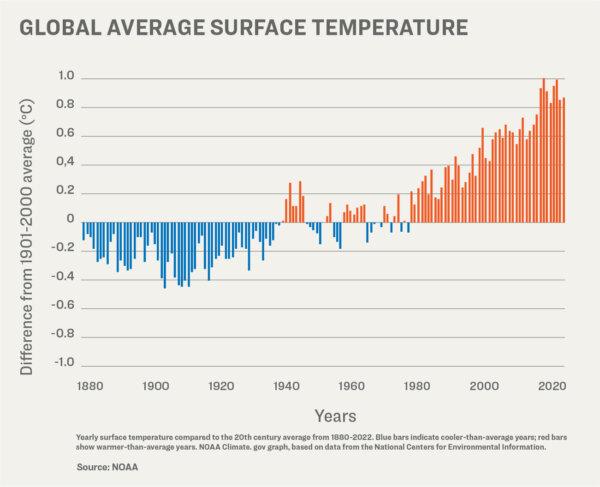
Global average surface temperatures have been variable, but show
an increasing trend in recent decades. (Illustration by The Epoch Times)
Over the years, he said, more and more infrastructure has been built up around the thermometer locations, and at night, the asphalt and concrete release the absorbed heat and push up the temperature.
“You can look at any set of climate data, no matter who produces it, and you can see this effect. The low temperatures are trending upward much faster, and the high temperatures are virtually unchanged. But it’s the average temperature that’s being used to track climate change,” Mr. Watts said.
He said that even though both NOAA and NASA claim that they can adjust their data to account for the urban heat island effect, the bias is impossible to overcome because the problem impacts 96 percent of surface stations.
Transient Temperature
The second primary bias that Mr. Watts identified is the transient temperature readings, which are short-term temperature changes that can give a false reading.NOAA started switching out their mercury thermometers in the mid-to-late 1980s, according to Mr. Watts.
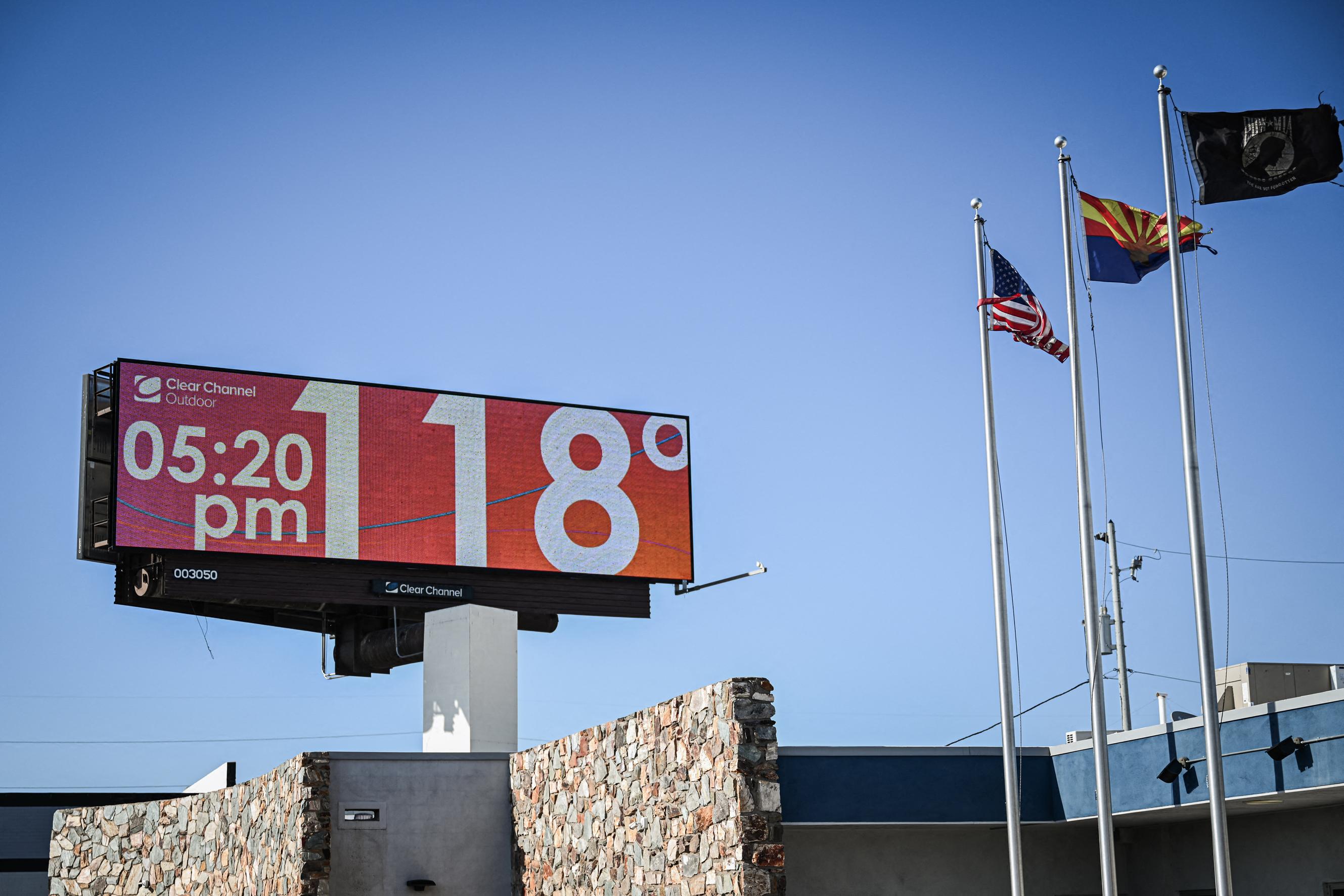
A billboard displays a temperature of 118 degrees Fahrenheit during a record heat wave
in Phoenix on July 18, 2023. (Patrick T. Fallon/AFP via Getty Images)
“But they’re only recording the high and the low temperature of the day, and these can be biased by simple effects of wind,” he said.
“For example, you can have one of these temperature sensors placed near a parking lot, which happens to be to the east of the thermometer. And the wind has been predominantly from the south all through the day. But then, all of a sudden, you get a wind shift, and the wind shift could be caused by a number of different things. It could be caused by a change in the weather patterns. It could be caused by something blocking the wind from the south, like a semi-truck pulling up nearby.
“So you get wind shifting out of the east suddenly, coming across the parking lot, and picking up that radiant heat. And the thermometer will respond to that in the space of a second or two. And it will report a high temperature from that wind gust that does not necessarily represent the weather that day. It’s an anomaly. And the same thing can happen at night.”
“These are the problems that NOAA has not really fully addressed,” he said. “The folks who do the climate data never leave the office, and they don’t administer these stations. They [the stations] are left to the National Weather Service field offices—and the National Weather Service field offices are understaffed.
“Some stations, like out here in the West, are hundreds of miles away or more from the National Weather Service office, so they can’t get out there and do maintenance regularly. And when the National Weather Service went to modernization in the early 1990s, they closed many Weather Service offices around the country.
“And so, the maintenance on these thermometers—and a lot of these monitors are run by the public, a lot are volunteers—has fallen off. I’ve had volunteers, when I go visit, ask me if I can get the Weather Service to come out and fix something. But they can’t, because the problem is, they don’t have the budget.
“This is not a rigorously scientifically controlled network at the operational level.”

Heat waves cause distortion on the horizon as a pedestrian walks along South Las Vegas Blvd
in Las Vegas on July 30, 2023. (Patrick T. Fallon/AFP via Getty Images)
Adjusting Temperature Readings
NOAA has also been adjusting historical temperature data.The February 1936 record for the Reykjavik station showed a mean temperature of minus 0.2 degrees Celsius for the month and an annual mean temperature of 5.78 degrees Celsius, according to the Goddard Institute for Space Studies Surface Temperature Analysis (GISTEMP). The original GISTEMP monthly data was known as v2, or version 2.
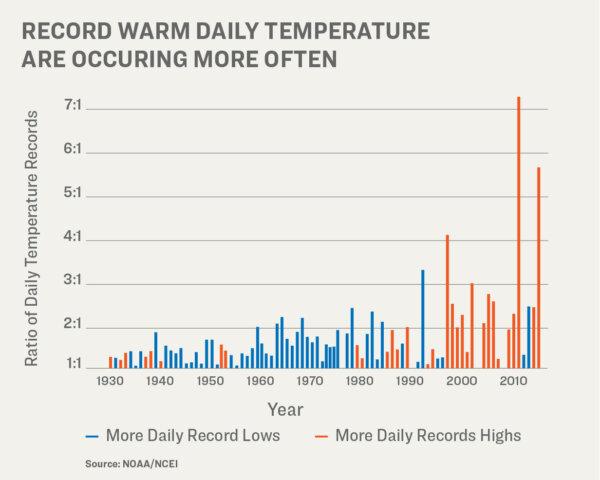
EPA data shows an increasing ratio of daily record high-to-low temperatures
in order to indicate rising global temperatures (Illustration by The Epoch Times).

Kosovo, on July 22, 2023. (Armend Nimani/AFP via Getty Images)
“Incredibly, the range of data adjustments exceeds 2 degrees Fahrenheit, which is significant with respect to current temperature trends,” Lt. Col. Shewchuk said.
“NOAA also employs a very unusual follow-on data adjustment process, where they periodically go back and re-adjust the previously adjusted data. This makes it difficult to find ground truth, which seems more like shifting sands.”
In response to The Epoch Times’ request for comment about the adjustments to historical data, NOAA’s public affairs officer, John Bateman, said he reached out to one of NOAA’s National Centers for Environmental Information (NCEI) climate experts, who responded: “NCEI applies corrections to account for historical changes in station location, temperature instrumentation, observing practice, and, to a lesser extent, siting conditions. Our approaches are documented in the peer-reviewed literature. At the national scale, the corrected data are in good agreement with the U.S. Climate Reference Network (USCRN), which has pristine siting conditions.”
Satellite Readings
To get a more accurate reading of the Earth’s fluctuating surface temperatures, Mr. Spencer and climatologist John Christy developed a global temperature data set from microwave data observed from satellites.Mr. Christy is a professor of atmospheric science at the University of Alabama in Huntsville and director of the Earth System Science Center, who, along with Mr. Spencer, received NASA’s Exceptional Scientific Achievement Medal for his work with satellite-based temperature monitoring.
They started their project in 1989 and analyzed data going back to 1979.
And while 2023 was the hottest year on record due to linear warming trends, they say it’s not a cause for public panic.
“Yes, it appears 2023 was the warmest in the last 100 years or so. But numbers matter. The magnitude isn’t large enough for anyone to feel,” Mr. Spencer said.
“Besides, a single year is weather, not climate. What matters is the long-term trend, say many decades.”
He said the 2023 data, added to the 45 years of data since 1979, doesn’t alter the overall trend of 0.14 degrees Celsius increase every 10 years
“I believe both satellites and thermometers show a warming trend, especially since the 1970s,” Mr. Spencer said.
“But the strength of that trend is considerably less than what climate models predict, and it is those models which are used to argue for changes in energy policy and CO2 emissions reduction.”
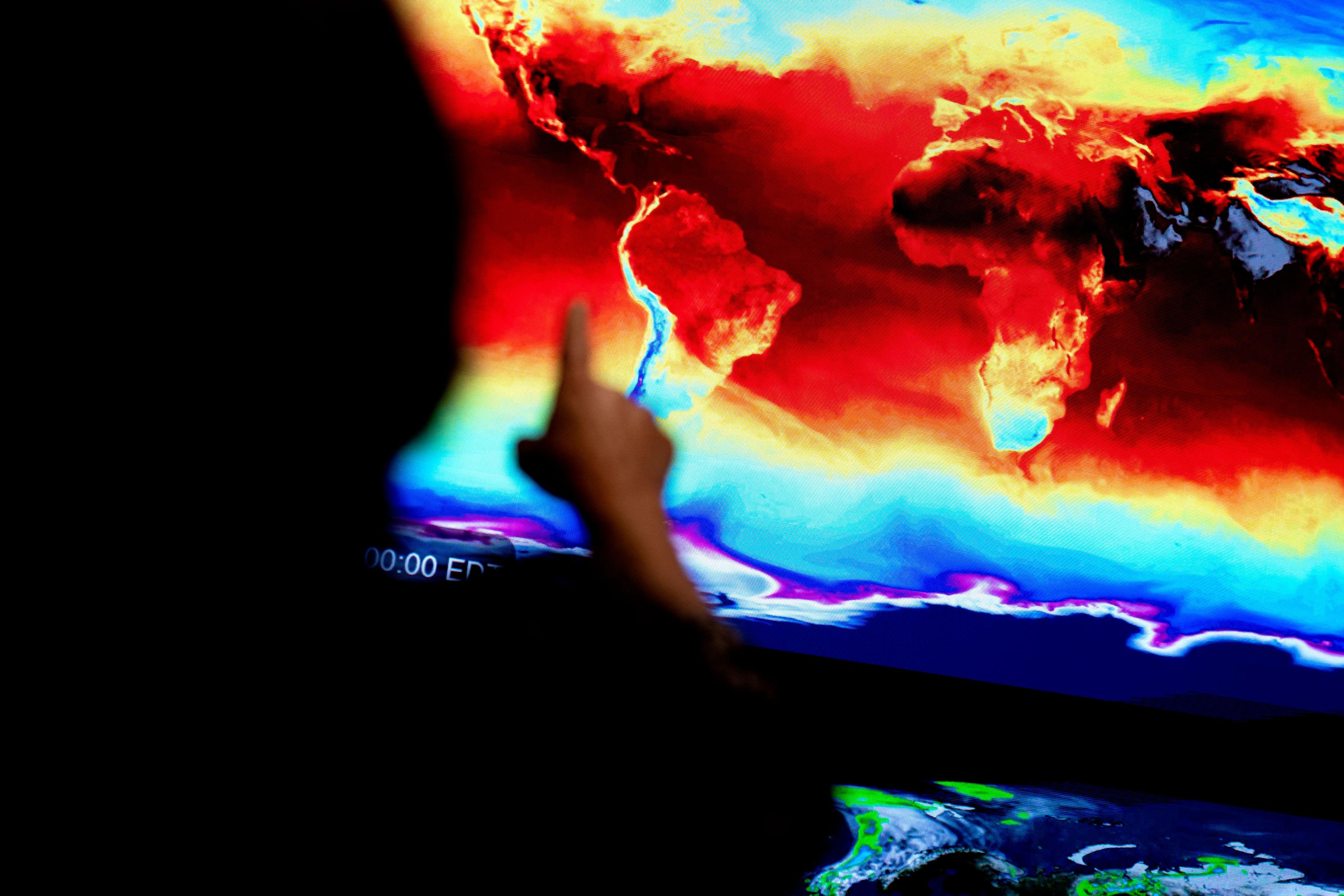
An employee gestures toward a global map showing information coming in from NASA satellites
at an exhibit at NASA headquarters in Washington on June 21, 2023.
(Stefani Reynolds/AFP via Getty Images)
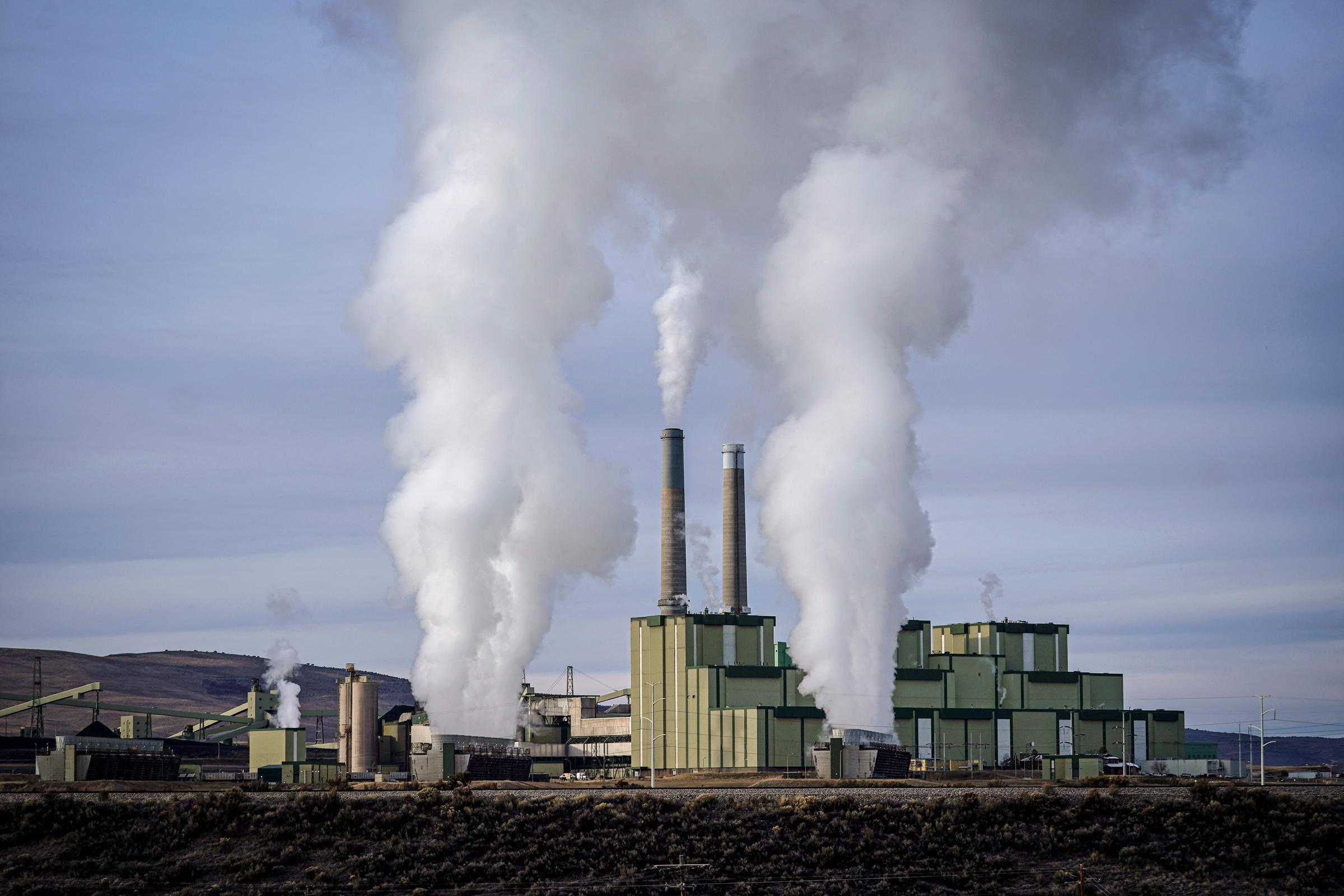
NASA Props Up Ground Readings
NASA claims on its website that ground thermometers are more accurate than satellite measurements.“While satellites provide valuable information about Earth’s temperature, ground thermometers are considered more reliable because they directly measure the temperature where people reside,” NASA stated.
“Satellite data require complex processing and modeling to convert brightness measurements into temperature readings, making ground thermometers a more direct and accurate source of temperature information for us.”
Mr. Spencer quickly pointed out the flaws in NASA’s claim.
“Surface thermometers only cover a tiny fraction of the Earth, whereas the satellites provide nearly complete global coverage,” he said.
“NASA’s complaint that the 16 separate satellites must be pieced together ‘like a jigsaw puzzle’ is ironic since the surface temperature record is pieced together from hundreds (if not thousands) of stations, with almost none of them, anywhere, providing a continuous, uninterrupted record unaffected by increasing urban heat island effects.
“Finally, the complaint is that satellites only measure the deep atmosphere, not the surface where people live. ... Well, if that is so, why are deep ocean temperatures touted as being so valuable for climate research? All of these measurements are important in their own right, and each system has its strengths and weaknesses. Our satellite dataset is widely used by climate researchers around the world.”
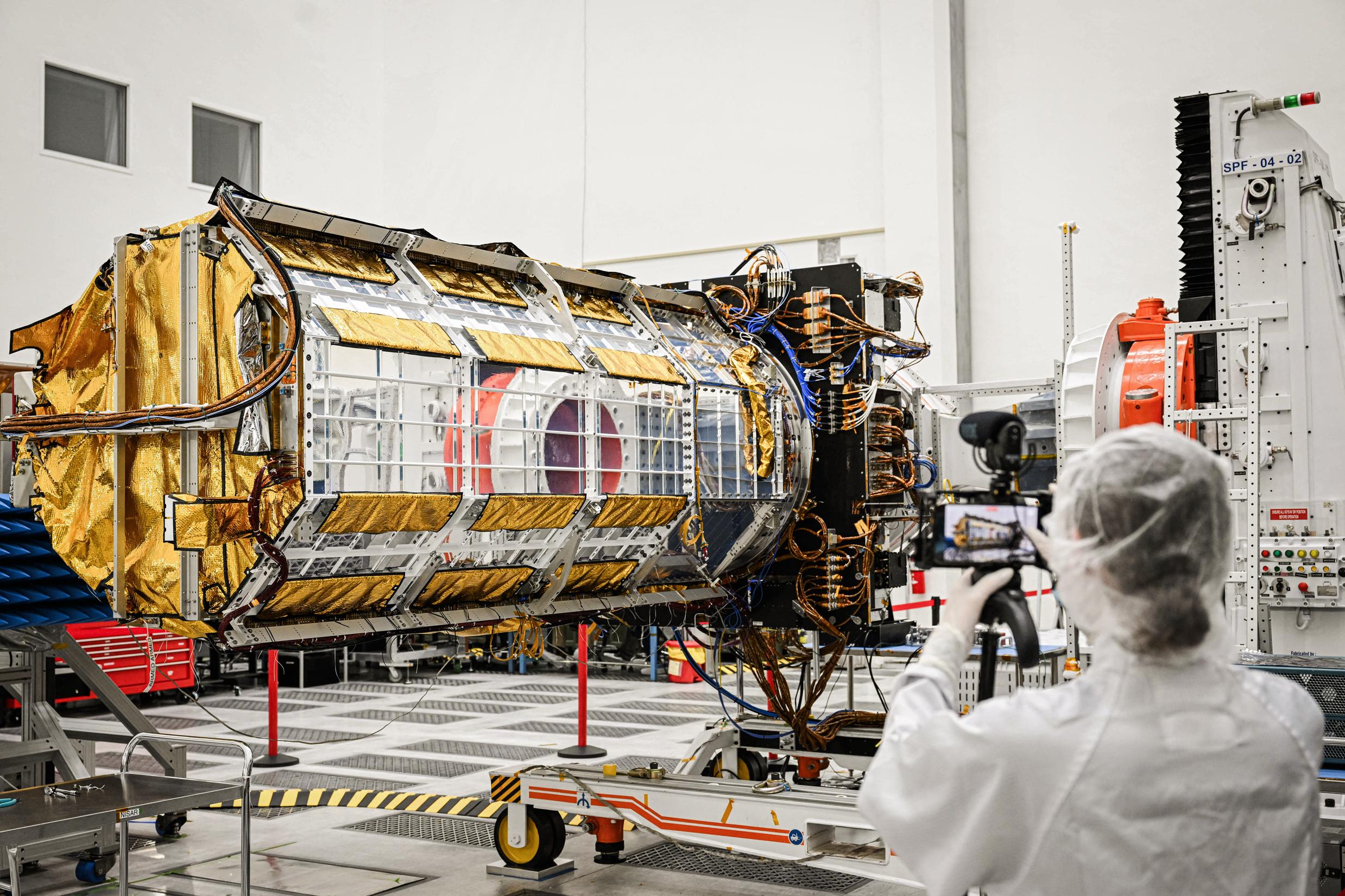
A videographer films the NISAR satellite, a joint Earth-observing mission between NASA
and the Indian Space Research Organization, inside NASA's Jet Propulsion Laboratory in Pasadena, Calif.,
on Feb. 3, 2023. (Patrick T. Fallon/AFP via Getty Images)
As to NASA’s critique that satellites don’t directly measure temperature but instead the brightness of Earth’s atmosphere, making them inaccurate, Mr. Spencer said: “Strictly speaking, that is true. But surface thermometers are electronic, so (technically) they measure electrical resistance.
“The satellites are calibrated with the highest quality, laboratory-standard platinum resistance thermometers. If NASA is going to fault remotely-sensed satellite data, they might as well shut down their myriad Earth satellite programs, which have the same (supposed) ‘defect.’”
Lt. Col. Shewchuk called NASA’s claim that satellite data is inferior to surface temperature readings “nonsense.”
“UAH satellite data is the only data source that is truly global in nature. It effectively measures the temperature of earth’s entire atmosphere, and especially the lower troposphere—where our weather is actually created,” he said.
“The only limitation is that the satellite data only begins in 1979.”
Mr. Watts said that when he looked at data from ground surface stations in grassy fields (absent an urban heat island effect), the temperature readings closely matched Mr. Spencer’s satellite data.
When asked why NOAA isn’t only using thermometers where there’s no possibility for an urban heat island effect, Mr. Spencer said: “I think their goal is not to get the most accurate long-term temperature record but to use as much thermometer data as they can get their hands on. This is good to build a congressionally-funded program and keep people employed.”
The current amount of money, $1.3 trillion annually, being spent on climate initiatives is nowhere near enough, according to the Climate Policy Initiative.
“This means that climate finance must increase by at least five-fold annually, as quickly as possible, to avoid the worst impacts of climate change.”
The organization lists its funders on its website, including the Rockefeller Foundation, WWF, and Bloomberg Philanthropies. Its partners include BlackRock, two U.N. climate groups, several large global banks, and government groups such as the Global Covenant of Mayors for Climate and Energy.













